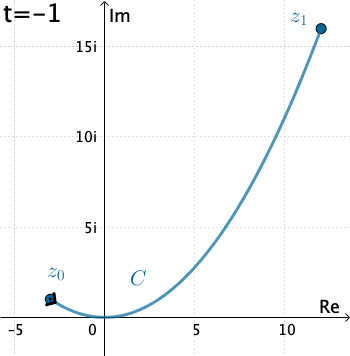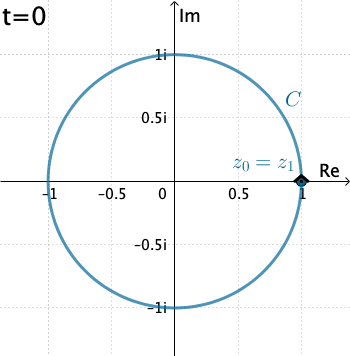Complex Integration
The magic and power of calculus ultimately rests on the amazing fact that differentiation and integration are mutually inverse operations. And, just as complex functions enjoy remarkable differentiability properties not shared by their real counterparts, so the sublime beauty of complex integration goes far beyond its real progenitor.
Contour integral
Consider a contour $C$ parametrized by $z(t) = x(t) + i y(t)$ for $a\leq t\leq b.$ We define the integral of the complex function along $C$ to be the complex number \begin{eqnarray}\label{contour-integral} \int_C f(z)\,dz = \int_a^bf\left(z(t)\right)z'(t)\,dt. \end{eqnarray} Here we assume that $f\left(z(t)\right)$ is piecewise continuous on the interval $a \leq t \leq b$ and refer to the function $f (z)$ as being piecewise continuous on $C.$ Since $C$ is a contour, $z'(t)$ is also piecewise continuous on $a \leq t \leq b$; and so the existence of integral (\ref{contour-integral}) is ensured.
The right hand side of (\ref{contour-integral}) is an ordinary real integral of a complex-valued function; that is, if $w(t) = u(t) + i v(t),$ then \begin{eqnarray}\label{integral-real-cv} \int_a^b w(t)\,dt = \int_a^b u(t)\,dt + i \int_a^b v(t)\,dt \end{eqnarray}
Now let us write the integrand $$f(z)= u(x,y)+ iv(x,y)$$ in terms of its real and imaginary parts, as well as the differential $$dz=\frac{dz}{dt}dt = \left(\frac{dx}{dt}+ i \frac{dy}{dt}\right)dt = dx+ i dy$$ Then the complex integral (\ref{contour-integral}) splits up into a pair of real line integrals:
Example 1: Let's evaluate $\int_C \overline{z}\, dz,$ where $C$ is given by $x=3t, y=t^2,$ with $-1\leq t\leq 4.$

Here we have that $C$ is $z(t)=3t+ it^2 .$ Therefore, with the identification $f(z)=\overline{z}$ we have $$f\left(z(t)\right)=\overline{3t+it^2}= 3t-it^2 .$$ Also, $z'(t) = 3 + 2it,$ and so the integral is \begin{eqnarray*} \int_C \overline{z}\, dz&=& \int_{-1}^4 \left(3t-it^2\right)\left(3+ 2it\right)dt\\ &=& \int_{-1}^4 \left(2t^3+9t + 3t^2i\right)dt\\ &=& \int_{-1}^4 \left(2t^3+9t \right)dt + i\int_{-1}^4 3t^2dt\\ &=& \Bigg. \left(\frac{1}{2}t^4 + \frac{9}{2} t^2\right)\Bigg|_{-1}^4 + i\Bigg. t^3\Bigg|_{-1}^4\\ &=& 195+ 65 i. \end{eqnarray*}
Example 2: Now let's evaluate $\displaystyle \int_C \dfrac{1}{z}\, dz,$ where $C$ is the circle $x=\cos t, y=\sin t,$ with $0\leq t\leq 2\pi .$

In this case $C$ is $z(t)=\cos t + i \sin t = e^{it},$ $$f\left(z(t)\right)=\frac{1}{e^{it}}$$ and, $z'(t) = ie^{it}.$ Thus \begin{eqnarray*} \int_C \dfrac{1}{z}\, dz&=& \int_{0}^{2\pi} \left(e^{-it}\right)ie^{it}dt = i \int_{0}^{2\pi} dt= 2\pi \,i. \end{eqnarray*}
Numerical evaluation of complex integrals
Exploration 1
Use the following applet to explore numerically the integral $$\int_C \overline{z}\, dz$$ with different contours $C$:
- Line segments.
- Semicircles.
- Circles, positively and negatively oriented.
You can also change the domain coloring plotting option. Drag the points around and observe carefully what happens. Then solve Exercise 1 below.
The arrows on the contours indicate direction.
Exercise 1: Use definition (\ref{contour-integral}) to evaluate $\displaystyle \int_C \overline{z}\, dz,$ for the following contours $C$ from $z_0=-2i$ to $z_1=2i$:
- Line segment. That is, $z\left(t\right) = -2i(1-t)+ 2it,$ with $0\leq t\leq 1.$
- Right-hand semicircle. That is, $z\left(\theta\right) = 2e^{i \theta}$ with $-\frac{\pi}{2}\leq \theta \leq \frac{\pi}{2}.$
- Left-hand semicircle. That is, $z\left(\theta\right) = -2ie^{-i \theta}$ with $0 \leq \theta \leq \pi.$
Use the applet to confirm your results.
What conclusions (if any) can you draw about the function $\overline{z}$ from this?
Exploration 2
Now use the applet below to explore numerically the integrals
$$\int_C \left(z^2+z\right) dz;\qquad \int_C \frac{1}{z^2}\, dz$$
with different contours $C$ (line segments, semicircles, and circles).
Drag the points around and observe carefully what happens.
You can select the functions z^2+z or 1/z^2
from the list at the left-top corner.
Then solve Exercises 2 and 3.
Exercise 2: Consider the integral $$I_1 =\int_C \left(z^2+z\right) dz.$$ Use the applet to analyze the value of $I_1$ in the following cases:
- $C$ is any contour from $z_0=-1-i$ to $z_1 = 1+i.$
- $C$ is the circle with center $z_0$ and radius $r\gt 0,$
$|z-z_0|= r$; positively or negatively oriented.
In this cases select
Circle ↺orCircle ↻.
What conclusions (if any) can you draw about the value of $I_1$ and the function $z^2+z$ from this?
Exercise 3: Now considering integral
$$I_2 =\int_C \dfrac{1}{z^2}dz.$$ First, in the applet select the function
f(z)=1/z^2.
Then analyze the values of $I_2$ in the following cases:
- $C$ is any contour from $z_0=-i$ to $z_1 = i.$
What happens when you select
Line Segmentin the applet? What happens when you selectSemicircles? - $C$ is the circle with center $z_0$ and radius $r\gt 0,$
$|z-z_0|= r$; positively or negatively oriented.
In this case select
Circle ↺orCircle ↻. What happens if $z = 0$ is inside or outside the circle? What happens if $z=0$ lies on the contour, e.g. when $z_0=1$ and $r=1$?
What conclusions (if any) can you draw about the value of $I_2$ and the function $\dfrac{1}{z^2}$ from this?
Properties
All the following familiar properties of integrals can be proved directly from the definition given in (\ref{integral-real-cv}). If $w(t)= u(t)+iv(t)$ and $s(t)= \upsilon(t)+i \nu(t)$ are complex-valued functions of a real variable $t$ continuous on an interval $[a,b],$ then
From definition (\ref{contour-integral}), and the properties just mentioned above, it also follows immediately that
Now consider the contour defined for the integral (\ref{contour-integral}). The contour $-C$ consists of the same set of points but with the order reversed so that the new contour extends from $z_2$ to $z_1,$ as shown in Figure 3.

The contour $-C$ has a parametric representation $z=z(-t)$ with $-b\leq t \leq -a.$ Hence
If we use the substitution $\tau = -t$ in the last integral, then
Hence, we obtain the following property
Consider now a path $C,$ parametrized by $z(t)$ for $t\in[a,b],$ that consists of a contour $C_1$ from $z_1$ to $z_2$ followed by a contour $C_2$ from $z_2$ to $z_3,$ the initial point of $C_2$ being the final point of $C_1.$ Then

Exercise 4: Use the properties for integrals of functions $w(t)$ to prove (\ref{sum-paths}).
Finally we introduce an inequality involving contour integrals that is extremely important in various applications. Consider $C$ a smooth curve parametrized by $z(t)=x(t)+ iy(t)$ with $t\in [a,b].$ Suppose that the components $x'(t)$ and $y'(t)$ of the derivative \[ z'(t) = x'(t) + iy'(t) \] are continuous on the entire interval $[a,b].$ Then the real-valued function \[ \left|z'(t)\right| =\sqrt{\left[x'(t)\right]^2+ \left[y'(t)\right]^2} \] is integrable on $[a,b].$ According to the definition of arc length from calculus, the length of $C$ is the number \[ L = \int_a^b \left|z'(z)\right|\,dt. \]
If $C$ is a contour of length $L$ and $f$ is a piecewise continuous function on $C,$ and $M$ is a nonnegative constant such that $\left|f(z)\right|\leq M$ for all points $z$ on $C$ at which $f(z)$ is defined, then \begin{eqnarray}\label{ML-inequality} \left|\int_C f(z)\, dz\right|\leq ML \end{eqnarray}
Note that since $C$ is a contour and $f$ is piecewise continuous on $C,$ a number $M$ appearing in the inequality $\left|f(z)\right|\leq M$ will always exist. The reason is that the real-valued function $\left|f\big(z(t )\big)\right|$ is continuous on the closed bounded interval $[a,b]$ when $f$ is continuous on $C;$ and this function always reaches a maximum value $M$ on that interval. Therefore $|f (z)|$ has a maximum value on $C$ when $f$ is continuous on it. This is also true when $f$ is piecewise continuous on $C.$
The property (\ref{ML-inequality}) is often used in the theory of complex integration and is sometimes referred to as the ML-inequality.
Example 3: Let $C$ be the contour of the circle $|z|=2$ from $z_1=2$ to $z_2=2i$ that lies in the first quadrant, as shown in Figure 5. We can use inequality (\ref{ML-inequality}) to show that \[ \left|\int_C \frac{dz}{z^2-1}\right|\leq \frac{\pi}{3}. \] without evaluating the integral.

Note that if $z$ is a point of $C,$ then
Thus \[ \left|\frac{1}{z^2-1}\right| = \frac{1}{ \left|z^2- 1\right|}\leq \frac{1}{3} \] Also the length of $C$ is $\dfrac{1}{4}(4\pi).$ Thus, if we take $M=\dfrac{1}{3}$ and $L= \pi,$ we find that \[ \left|\int_C \frac{dz}{z^2-1}\right|\leq ML = \frac{\pi}{3}. \]
Example 4: We can also use the ML-inequality to find the value of the integral \[ \lim_{R\to \infty} \int_{C_R}\frac{z^{1/2}}{z^2+1}dz \] where $C_R$ is the arc $z(t)= Re^{it},$ with $t\in[0,\pi]$ and $z^{1/2}$ denotes the branch \[ z^{1/2} = \exp\left(\frac{1}{2}\log z\right) = \sqrt{r}e^{it/2},\quad \left(r>0,-\frac{\pi}{2}\lt t \lt \frac{3\pi}{2}\right) \] of the square root function.

Note that when $|z|=R\gt 1,$ then $\abs{z^{1/2}}= \abs{\sqrt{R}e^{it/2}} = \sqrt{R}$ and \[ \abs{z^2+1}\geq \abs{\abs{z^2}-1} = R^2-1. \] Thus, at points on $C_R$, we have
Since the length of $C_R$ is $L=\pi R,$ using (\ref{ML-inequality}), we obtain
The term on the right tends to zero as $R$ tends to infinity. Hence \[ \lim_{R\to \infty} \int_{C_R}\frac{z^{1/2}}{z^2+1}dz=0. \]
Antiderivatives
While the value of a contour integral of a function $f (z)$ from a fixed point $z_0$ to a fixed point $z_1$ generally depends on the chosen path, there are certain functions for which the integrals from $z_0$ to $z_1$ have values that are independent of path, as you have seen in Exercises 2 and 3. These examples also illustrate the fact that the values of integrals around closed paths are sometimes, but not always, zero. The next theorem is useful in determining when integration is independent of path and, moreover, when an integral around a closed path has value zero. This theorem is known as the complex version of the Fundamental Theorem of Calculus and involves the concept of antiderivative (or primitive) of a continuous function $f(z)$ on a domain $D,$ that is, a function $F(z)$ such that $F'(z)=f(z)$ for all $z\in D.$
As a consequence of the previous Theorem 1, for closed curves we have \begin{eqnarray} \int_{C} f\left(z\right)dz=\int_{C}F^{\prime}(z) dz=0. \end{eqnarray} for every closed contour $C,$ that is, the endpoints are equal.
If the function $f(z)$ satisfies the hypothesis of Theorem 1, then for all contours $C$ lying in $D$ beginning at $z_1$ and ending at $z_2$ we have expression (\ref{FTC}). Hence the result demonstrates that the integral is independent of path. This fact is illustrated in Figure 6.

Considering Figure 6, we have $$\int_{C_1} f\left(z\right)dz=\int_{C_2} f\left(z\right)dz$$ because
In addition, we have the following sufficient condition for the existence of an antiderivate:
Using properties of the integral we have
Since $D$ is a domain, we can choose $\Delta z$ so that $z + \Delta z$ is in $D.$ Furthermore, $z$ and $z + \Delta z$ can be joined by a straight segment, as shown un Figure 7. This is the contour we use in the last integral in (\ref{anti-def}). For $z$ fixed, we can write

From (\ref{anti-def}) and (\ref{anti-expand}) we obtain
Now, since $f$ is continuous, for any $\epsilon\gt 0 $ there exists a $\delta\gt 0$ such that $\abs{f(s)-f(z)}\lt \epsilon$ whenever $\abs{s-z}\lt \delta.$ Thus, if we choose $z+ \Delta z$ close enough to $z$ so that $\abs{\Delta z}\lt \delta,$ it follows from the ML-inequality that
Therefore, we have proved that